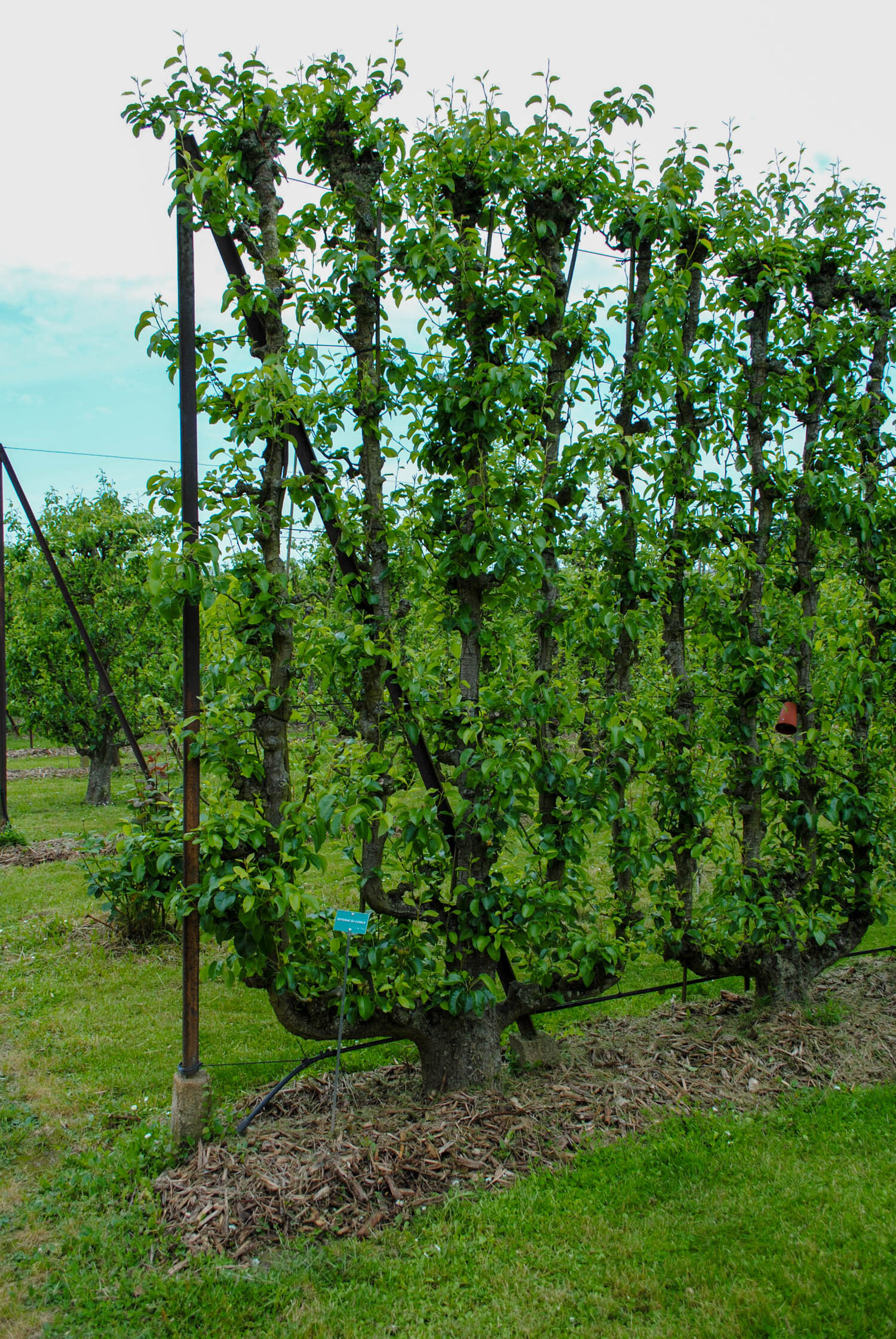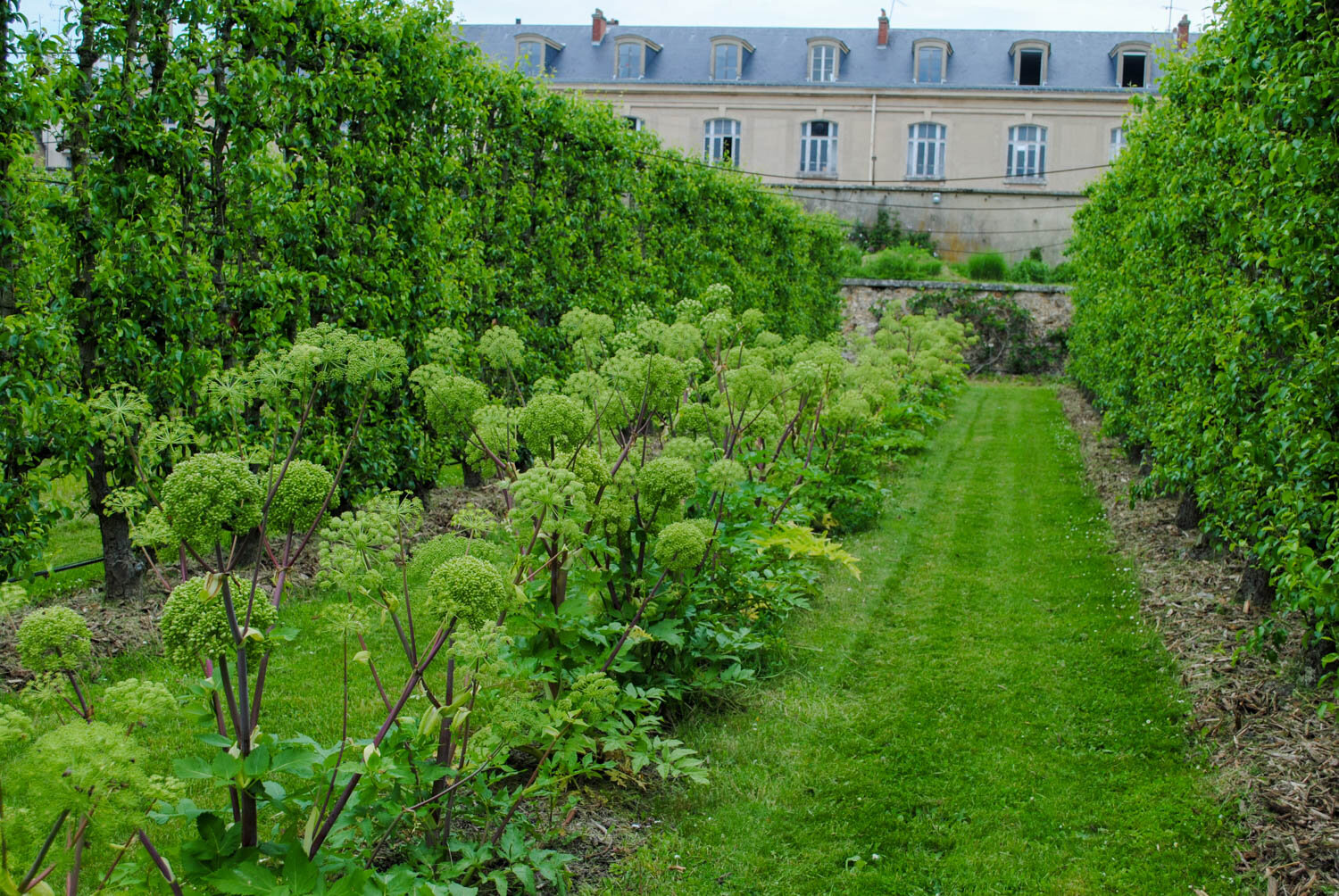In late May a few years ago, I helped lead a student trip to France. A few of them joined me on a free-day excursion to Potager du Roi, the twenty-five acre kitchen garden for the palace of Versailles and King Louis XIV. The flourishing garden was a source of food for not only meals for the king and his family but also special guests and feasts. Today, it still serves as a source of inspiration for gardeners.
The King’s Vegetable Garden was built in 1683 after five years of construction, and the design that was originally created then hasn’t changed much. Upon entering this space, one might never guess that it was once a swamp that had to be drained and have rubble placed underground to allow the soil to dry out. Formal lines now occupy this once wet wilderness. At the center of the garden, sixteen rectangular-shaped beds are arranged around a fountain. Another twenty-nine gardening areas surround this area.
A fountain sits at the center of Potager du Roi.
Much of the garden’s success was due to the efforts of Jean-Baptiste La Quintinie. La Quintinie was a lawyer until he saw incredible gardens on a trip to Italy and changed his career path. (See, even 300 years ago, people were coming to horticulture after making other life choices). He read much about cultivating plants, and his passion would eventually be recognized by King Louis XIV who gave him the role of “director of all royal fruit and vegetables gardens.” La Quintinie was so dedicated that he would even send shipments of produce when the king was traveling.
Reading in Le Potager du Roi by Stéphanie de Courtois about La Quintinie and his experiments reminded me of my early gardening pursuits with cold frames and covers. He used manure and glass to extend the season for crops. In his book Instruction pour les Jardins Fruitiers et Potagers, he said,
“Heat in the earth and in the air can only be produced regularly from the sun. I have to admit that I was more than a little happy, however, to imitate it in order to benefit certain fruit. I have succeeded in ripening five or six weeks before their time, strawberries at the end of March, peas in April, figs in June, asparagus and lettuces in December and January…”
Another quote of his has become one of my favorites. “A good gardener should always be looking for new ideas.” A man after my own heart.
Don’t all horticulturists aspire to have a statue of themselves holding a grafting knife erected somewhere?
Over the years, interest in Potager du Roi producing food would ebb and flow but never fully wane. However, after the French revolution, the garden would shift its purpose from nurturing the stomachs of royalty to nurturing the minds of students. In 1849, Potager du Roi would become a learning garden for students in the National Agronomic Institute in Versailles under the stewardship of Auguste Hardy. Under his leadership, the school became self sufficient from all the produce grown and sold with the help of fifty student workers, and the students learned the intricacies of horticultural practices within a two-year period. By 1900 the garden would become well known for the caliber of graduates it produced.
Bee hives nestled under fruit trees in Potager du Roi.
After a hard winter in 1879 and 1880, Hardy increased the collections of apples to over 300, pears to over 500, and peaches to almost 100. It was then that he introduced more espalier shapes into the garden and eventually over thirty different espaliers would be used.
Espaliered fruit trees were used extensively throughout Potager du Roi.
In the 1900’s as more theoretical horticulture was taught, students began spending less time in the garden but still used Potager du Roi as a living lab for classes. Conserving the site also became a focus. The site was listed as a heritage building in the 1920’s. In the 1990’s the garden would fall under the direction of French National Landscape Architecture School and with help from the World Monuments Fund would see some needed repair to parts of the garden. However, the thread of experimentation and learning that started with La Quintinie is still alive today in Potager du Roi with student gardens providing space for learning and the staff gardeners trying new varieties and keeping the historical horticulture practices alive.
Here you see part of the student garden. Such a pastoral feel within the city.
More of the student garden plots. Note the plots are marked with sunken logs. Also, simple yet effective trellises have been employed.
WHAT I LEARNED
The biggest inspiration I took from the garden was seeing all the different types of espaliers. Fruit trees were trained in a myriad of shapes in the garden including low fences, wavy lines, circles, pyramids, and even a vase-shaped tree. Just look at these pictures below. It is mind-blowing the attention to detail and the patience.
A candelabra cordon. For future reference, a cordon is the name of a training system in orchards and vineyards where a permanent branch or branches support offshoots.
I loved seeing these fence-type cordons. It gave me the idea to one day try it back home with figs or other southern fruits.
Angelica planted between rows of espaliered apples.
Here we see shoots coming off an oblique cordon.
I think most of us have seen some form of plant contortion like from the photos above, but I don’t know if you’re ready for the awesomeness that follows.
There were circles!!!
There were waves!!!
There were pyramids!!!
AND, THERE WAS THIS AMAZING VASE-SHAPED ESPALIER!!! I MEAN LOOK AT IT!?!?!
MIND BLOWING, RIGHT!?!
Seeing the guides in place helps one understand just how they can achieve this level of plant manipulation.
Frames for guiding the eventual espaliers.
But, what about the vase? That was likely achieved through a technique called topworking. Topworking is a special type of apical graft where the top of the plant is cut off and several new pieces of scion are inserted into the rootstock. And, while at Potager du Roi, I saw one for the first time!
A successful topworked graft! You read about these techniques in books, and then actually seeing them is so impressive.
I was also inspired from seeing the vegetables growing in the garden. Many were intercropped together along the wall that ran the lengths of the garden.
Here chives, fava beans, and English peas grow together in a bed.
The wall provides support for trellising English peas.
Here we see more intercropping. Chives once again flanks the planting of an Allium, what appears to be celery, lettuce, and fava beans.
An herb garden against the wall at Potager du Roi is the perfect place to site an insect hotel.
A few straggler weeds grow amongst chamomile and borage.
I can’t resist photographing the star-shaped flowers of borage, and this bee can’t resist enjoying them either!
If you ever get a chance to go to Paris, I highly recommend you visit Potager du Roi near the Palace of Versailles. The garden is imbued with over 300 years of history, and it was enchanting to see practices that while old may need to return to use in today’s small yards. The students and I left inspired, and I’m sure you will, too.
One last look at Potager du Roi with the Versailles Cathedral in the background.























